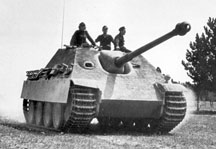Before Amarillo Design Bureau...
Before Task Force Games...
Steve Cole ran a game company called JagdPanther Publications. Named for the "hunting panther" tank destroyer on the box of his favorite wargame (PanzerBlitz), this magazine produced 15 issues between 1973 and 1976, along with a dozen independent games. These ancient magazines have been out of print for decades, and old copies change hands on Ebay for $100 or more.
Now, the archive boxes for this company have been located, and we are scanning the products into PDFs and uploading them to Warehouse 23, DriveThru RPG and Wargame Vault so they will be available to collectors and game historians. Hard copies of the scanned issues are available on our shopping cart.
This was an ancient age, just one step up from carving game rules on clay tablets. The year 1973 was at the very dawn of the independent wargame publishing companies. Typesetting was done with a manual typewriter, print-on-demand meant the photocopier at the library, counters were printed on paper (and drawn by hand), page layout was done with scissors and cellophane tape, and two guys in a garage could turn out a wargame magazine that won two Origins Awards. The point was creativity, new ideas, and imagination. Production values would have to come later. |
Magazine Issues |
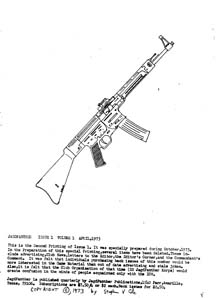 |
Issue #1:
This is a PDF scan of a copy of the magazine from Steve Cole's personal archives. It includes cover art he created on an old-style drafting board, the squad-level WWII game MP44, a football game called Scrimmage IV, and Cowpens (a little tactical game from the American Revolution; this copy lacks the Cowpens map which has not yet been found in the archive but will be added later). Also included is an article on mechanized combat, a variant for Borodino, and a review of Strategy 1.
At the time, Steve Cole's passion was the Avalon Hill game PanzerBlitz, and he launched a project he called PanzerBlitz Unlimited, which meant a lot of scenarios and new units for that game. This issue included units for the Korean War and a lot more WWII units (for Germany, Hungary, Romania, Norway, Finland, Poland, Italy, France, Britain, Holland, the USA, Japan, Belgium, and Russia).
Because Steve Cole (against the advice of everyone) did this magazine on 14-inch paper, this scan breaks each of the 22 original pages into two modern 11-inch pages, plus the maps and countersheets.
Buy on Warehouse 23.
Buy on Drive Thru RPG
Buy on Wargame Vault
Buy a hard copy
|
 |
Issue #2:
This is a PDF scan of a copy of the magazine from Steve Cole's personal archives. It includes cover art he drew by hand, ACAV (a PanzerBlitz variant for Vietnam, basically a complete major game), Fliegenkampf (close air support rules for PanzerBlitz created by Al Hall, an Air Force pilot who flew F-4s over Vietnam), variants for several games (US troops in Stalingrad and Barbarossa, Japanese and Germans in Korean War, replacements in Anzio, Laos in Year of the Rat, Americans in France 1940, Diplomacy, night raids in Luftwaffe, naval bombardment in Guadalcanal), an article on land warfare, Principles of Wargaming (article), a Dogger Bank scenario for Jutland (with a hand-drawn counter for the Blucher), an article on naval miniatures, an article on armor miniatures, a review of Up Against the Wall, an article on private armies, a filksong to the tune of Hawaii-5-0, a review of S&T back issues, a tiny game (Crazy Horse) about hunting buffalo from horseback with a bow and arrow, and a one-page game called Eban Emael about the famous airborne attack in WWII.
Because Steve Cole (against the advice of everyone) did this magazine on 14-inch paper, this scan breaks each of the 19 original pages into two modern 11-inch pages, plus the maps and countersheets. (This is a scan of the second printing, which had eliminated some obsolete advertisements.)
Buy on Warehouse 23.
Buy on Drive Thru RPG
Buy on Wargame Vault
Buy a hard copy
|
 |
Issue #3:
Take another journey with us back to 1973, when a small wargame club in Amarillo, Texas (led by Steve Cole) produced a magazine filled with articles, variants, and reviews. Production values had not improved, and we still printed on that insane 14" paper. (The pages are divided in half for this 32-page PDF version.)
ARTICLES included a puzzle, some club news, editorials, minis vs counters, armor miniatures, tactics in Diplomacy, some business experiments that never worked (command college for wargamers, PBEM games that few played and no one finished), a survey of game ideas, and some of the stupidest editorial drivel that Steve Cole ever published.
REVIEWS included Richthoffen's War, Fall of Rome, Poor Bloody Infantry, and Rifle & Saber.
VARIANTS included the British Army in Gettysburg, Black Star Blue Star, UFOs in Foxbat and Phantom, the No-Normandy Option for Anzio, Zulus for Rifle & Saber, Foxboom & Bantam, Anti-aircraft for Foxbat & Phantom, Pacific theater aircraft for Luftwaffe, Realistic Midway, Panzerblitz table of organization for the 1st Marine Division, and an Origins of Vietnam variant for Origins of WW2.
Buy on Warehouse 23.
Buy on Drive Thru RPG
Buy on Wargame Vault
Buy a hard copy
|
 |
Issue #4:
This issue includes several features:
- Cover art by James McNease including the previously unknown Panzer-X Jaguar with seven road wheels.
- Editorial by Steve Cole (who, today, has no idea what he meant back then) including the original ball point pen corrections of the typewritten pages.
- Club news (of a club that never did anything, oh well).
- GRAF SPEE: a simple miniatures game with hand-drawn ship "miniatures" and rules.
- SNIPE HUNT: new rules for SPI Sniper including medics, pistols, flak vests, grenade pistols, motorcycles (with sidecars).
- SIDI REZEGH: An expansion of Panzerblitz for the North African campaign with hand-drawn tank counters for British and German forces.
- PANZERBLITZ RULES including surface-to-surface missiles, bridges, overloaded trucks, bypassing ditches, rampaging tanks, ferries, fairies, wading tanks, outposts, dig in, crack units, retreat before combat, snipers, trains, interdiction, opportunity fire, armor storm, infantry riding on tanks, stacking, unit buildup and breakdown, captured guns, immediate attack on passing infantry, lift and shift artillery fire, armored vehicle radios, preplanned artillery fire, tanks towing artillery, close assaults on artillery, poor communications rules, field telephones, runners, green units, towns, partisans, splitting artillery fire, sky troops, horse drawn sleds, chainlink fences, swimming rivers, dust clouds, caves and tunnels, and dozens of other rules.
- ADLER KAMPF: A combination of Midway, Battle of Britain, Fliegenkampf, Spitfire, and Panzerblitz. Basically a way to fight air battles over tank battlefields.
- HALOCAUST, a Game of World War 4. That's right, SVC did not know how to spell holocaust. Oh well. This was basically a rewrite of the Rick Loomis nuclear war play by mail game with a ton of extra rules like submarines, bombers, and so forth. There is no proof of the rumor that this project later inspired Rick Loomis to turn Nuclear War into his long-time smash hit card game.
- GAME REVIEWS of several games, some of which might not have actually existed.
- KOMET UND METEOR, an air combat game based loosely on some SPI games available at the time but focused on the jet fighters at the end of World War II (and slightly after the end of that conflict). The later printing of this issue on which this reprint was based includes the errata!
Production values had not improved, and we still printed on that insane 14" paper. (The pages are divided in half for this 32-page PDF version.)
Buy on Warehouse 23.
Buy on Drive Thru RPG
Buy on Wargame Vault
Buy a hard copy |
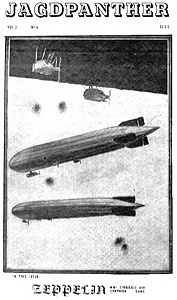 |
Issue #5:
This issue includes several features:
- Cover art of Zeppelins by James McNease.
- Editorial with rambling comments on what was going in the Amarillo group and the industry at large.
- Variants for the SPI game World War II covering things they forgot, omitted, or didn't consider worth mentioning.
- A variant for Turning Point moving the SS divisions from another theater to that game.
- A variant for Avalon Hill's 1914 game assuming that the US Army showed up early.
- A list of ways to balance the Avalon Hill game Stalingrad.
- A variant for Guadalcanal introducing the German 2nd Mountain Division and other units including Australians, the US 82nd Airborne, the German 2nd Parachute Division and 15th Panzer Division.Assorted new rules for Luftwaffe continuing the game into 1947. This included B29s, a US base in Norway, transfers via Gibraltar, the Italian Air Force, more jets (British, Russian, American), and much more.
- World War II naval miniatures rules.
- Suggested rules changes for Second Galactic War.
- A way to link the games Trireme and Centurion.
- The most confusing rules for Diplomacy.
- American troops in Moscow Campaign.
- A column on Napoleonic Miniatures.
- A review of the game Spitfire.
- The complete game Zeppelin covering the World War I aerial warfare campaign over Britain.
Production values had not improved, and we still printed on that insane 14" paper. (The pages are divided in half for this 32-page PDF version.)
Buy on Warehouse 23.
Buy on Drive Thru RPG
Buy on Wargame Vault
Buy a hard copy
|
 |
Issue #6:
This issue includes several features:
- The usual editorials, news, and some flamewar stuff.
- Chess as a wargame.
- A review of a game we published (Rigelian Wars). Turns out, we could not spell Rigellian.
- The World War III super-variant. This was a series of extension maps for an SPI NATO game adding Austria, Denmark, Berlin, Northern Norway, the Balkans, and Taiwan. Rules were included to play the game simultaneously with other games covering the Middle East and China.
- There was a huge section of Q&A about military history, terms, tactics, and equipment.
- Other articles/variants included Bismarck, Diplomacy, Heavy Cruiser, Kriegsmarine, and others.
Quality varies from page to page, as this is a scan of a 39 year old copy that wasn't printed very well (from typewritten plates). Some pages are difficult to read but are the best we can do and you can, with patience, figure them out.
Production values had not improved, and we still printed on that insane 14" paper. (The pages are divided in half for this 32-page PDF version.)
Buy on Warehouse 23.
Buy on Drive Thru RPG
Buy on Wargame Vault
Buy a hard copy
|
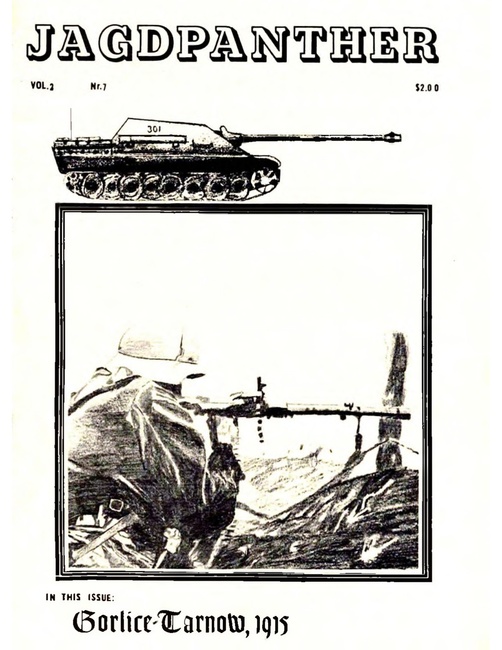 |
Issue #7:
Take yet another journey with us back to 1974, when a small wargame club in Amarillo, Texas (led by Steve Cole) produced an award-winning magazine filled with articles, variants, and reviews. Production values had not improved (layout was done by hand with glue sticks on cardboard; some of the typewriter produced pages printed better than others), and we still printed on that insane 14" paper. (The pages are divided in half for this PDF version.) Cover art by James McNease who drew it from a photo.
This issue included the complete game Gorlice-Tarnow 1915, based on the continent-wide campaign on the Russian front in that year. This was designed by a local gamer (Mike Harris) who was a World War I aficionado. As before, the counters were on paper; the gamers had to mount them by themselves. The map came on five sheets of paper and had to be pieced together by the players without much in the way of directions.
As you can see, the editors and writers packed a lot of stuff into 24 pages, but things were about to change for JagdPanther. Issue #8 would see many changes (to the 11" bound magazine format).
JagdPanther #7 marked the end of an era.
Buy on Warehouse 23
Buy on Drive Thru RPG
Buy on Wargame Vault
Buy a hard copy
|
 |
Issue #8:
Take a journey with us back to 1975, when a small wargame club in Amarillo, Texas (led by Steve Cole) produced an award-winning magazine filled with articles, variants, and reviews. This issue marked a watershed in many ways, and might be considered the Bronze Age of JagdPanther. The cover was actually a photograph taken during World War II, but the cover was still black and white (as were all the inside pages in every issue). The magazine was now 11 inches tall, and printed on 11x17 paper so it could be bound as a book. (The first seven issues had been on 14-inch paper and stapled into books.) Counters were still paper printed and "ready-to-mount" by wargamers seeking innovative new games and willing to glue their counters to whatever sheet of cardboard came to hand and cut them out with a stout pair of scissors.
The game in this issue was PQ17, based on naval battles in the Arctic Ocean during 1942 and 1943. This came with a map, rules sheet, and those paper counters.
The issue marked a welcome change to our readers, although it continued the continual confusion over volume and issue numbers. While this was JagdPanther #8, it was marked Volume 2 Issue 8. There was no Volume 2 Issues #1-#4, since Volume 2 consisted of issues #5-#8. There really was no reason to have "volume" involved at all, but the publisher had seen it on other magazines and thought every magazine had to have it. Unfortunately, he never understood how it worked, and did it all wrong.
Buy on Warehouse 23
Buy on Drive Thru RPG
Buy on Wargame Vault
Buy a hard copy
|
 |
Issue #9:
Back in 1975, a small wargame club in Amarillo, Texas (led by Steve Cole) produced an award-winning magazine filled with articles, variants, and reviews.
Major articles included a system for random event cards for use in almost any game, a variant of the Spanish Civil War game covering a potential uprising against Franco in 1940, revisions for Third Reich (including German amphibious units, ways to bet money on the game, German and Italian and Russian paratrooper units, and the London Blitz), a review and analysis of El Alamein, ways to combine the Goetterdaemmerung map in the issue with France 1940 to allow the French to invade Germany first, more new ships for the game CA, a major revision to the game War in the East, rules to realistically limit Russian artillery in Panzerblitz, a new empire for Starforce Alpha Centauri, a review and revision of the game Wolfpack, and a variant for Turning Point.
The big draw of the issue was the complete game Goetterdaemmerung. (One feature of the game seemed to be how many different ways could be found to spell the title.) This game largely used the War in the East game system with a map that connected perfectly along the mutual edges. The game included paper counters, a 14x22 map of Germany, and four pages of rules.
Buy on Warehouse 23
Buy on Drive Thru RPG
Buy on Wargame Vault
Buy a hard copy
|
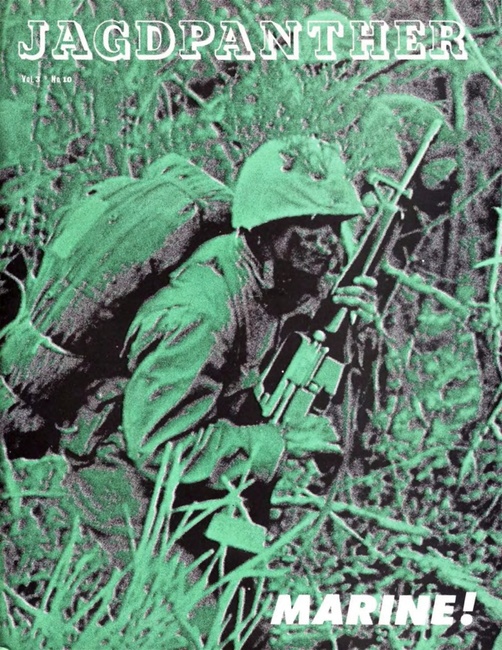 |
Issue #10:
Back in 1975, a small wargame club in Amarillo, Texas (led by Steve Cole) produced an award-winning magazine filled with articles, variants, and reviews.
Major articles focused on a package of six variants for the game Sixth Fleet, a humorous scenario for PanzerBlitz involving a stockpile of wine (sought by US, British, Soviet, and SS troops), strategy and a variant for Spanish Civil War, a solitaire variant for the game 1914, strategies and variants for Third Reich, merging Panzer Leader rules into PanzerBlitz, a 1941-45 variant for the game Winter War, strategy for Diplomacy, a history article about King Arthur, and Zeppelins for Richthoffen's War.
The game in the issue was Marine! This was one of those semi-generic tactical games with a map of typical beachhead terrain and units comprising squads and heavy weapons. A player could build any battle by just counting out the right number of units and picking an appropriate part of the map. The "lead article" described "the mission and the man" of the Marines of all nations.
Buy on Warehouse 23
Buy on Drive Thru RPG
Buy on Wargame Vault
Buy a hard copy
|
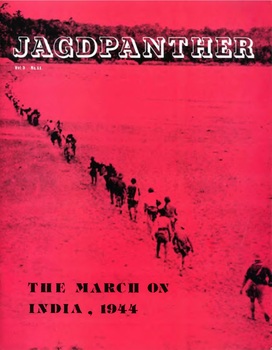 |
Issue #11:
Take a journey with us back to October 1975, when a small wargame club in Amarillo Texas (led by Steve Cole) produced an award-winning magazine filled with articles, variants, and reviews. The "Iron Age" of JagdPanther continued with color cardstock covers, one-piece multi-color maps, and die-cut counters.
The big game in this issue was The March on India by Thomas J. Fowler. This was a little known Japanese Imphal-Kohima offensive in 1944 that caught the British off guard and could have penetrated into India itself.
Variants were given for World War 3, The Fall of Tobruk, Spanish Civil War, Oil War, World War I, Schutztruppe, Blitzkrieg, Triplanetary, Overlord, Marine!, Modern Battles, Gettysburg, Panzerblitz, Richthoffen’s War, Gar-Garouk, Dreadnought, Sinai, D-Day, and Zeppelin.
New scenarios were presented for Panzerblitz (a balanced tank battle), Third Reich, Napoleon at Waterloo (French and Prussian units that historically did not arrive), Tank (a breakthrough battle), and SSN (a simpler introductory scenario).
This issue has been scanned from the best available copy.
Buy on Warehouse 23
Buy on Drive Thru RPG
Buy on Wargame Vault
Buy a hard copy
|
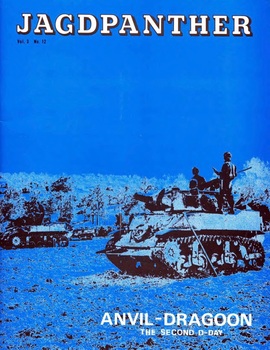 |
Issue #12:
Take a journey with us back to January 1976, when a small wargame club in Amarillo Texas (led by Steve Cole) produced an award-winning magazine filled with articles, variants, and reviews. The "Iron Age" of JagdPanther continued with color cardstock covers, one-piece multi-color maps, and die-cut counters.
The big game in this issue was Anvil-Dragoon, which was the allied invasion of southern France two months after Overlord. (Steve Cole's father was in that invasion and had actually suggested the idea.) The one-page history article included some pretty hard-hitting points about the British not wanting to see the operation done at all.
Variants were given for Anzio, Soldiers, War in the East, Schutztruppe, Dreadnought, March on India, Stellar Conquest, Von Manstein, World War II, World War 3, Fall of Rome, Rifle and Saber, 1776, Korea, Luftwaffe, Mech War, Sniper, Guerrilla, Sinai, combined arms battalions (for Tank, Mech War 77, and Wurzburg), Fredericksburg, Fast Carriers, Sorcerer, Robert E. Lee as a Yankee in American Civil War, Third Reich, and brigade breakdown units in Civil War games (Gettysburg, Lee vs. Meade, Cemetery Hill).
New scenarios were presented for Fast Carriers (mini-scenarios), Kursk (adding the Sixth Army assuming it escaped Stalingrad), Marine (solitaire), and the flight of the German battlecruiser Goeben in Dreadnought.
This issue has been scanned from the best available copy.
Buy on Warehouse 23
Buy on Drive Thru RPG
Buy on Wargame Vault
Buy a hard copy
|
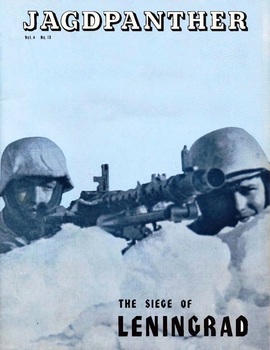 |
Issue #13:
Take a journey with us back to April 1976, when a small wargame club in Amarillo, Texas (led by Steve Cole) turned into a real company that produced an award-winning magazine filled with articles, variants, and reviews. The "Iron Age" of JagdPanther continued with color cardstock covers, one-piece multi-color maps, and die-cut counters.
The game in this issue was SIEGE OF LENINGRAD, a typical WW2 game with German division-sized counters (some of which could break down into three regiments) battering their way through fixed Russian defenses to grab the city of Leningrad. The history article focused on the failures of Germany's Army Group North to get moving and take the city when doing so would have been easy.
Rules variants included a fourth victory condition for Rand's SARATOGA 1777, a revised command and control system for PANZER ARMEE AFRIKA, optional rules for the SPI pocket game ARNHEM, random rules for generals in AMERICAN CIVIL WAR, alternate rules for the SPI game DIXIE (which set the Civil War in 1935), alternate rules for the four games of the SPI WEST QUAD game, and true wargame rules for the SPI game SORCERER.
Alternate history scenarios included a fascist France option for ORIGINS OF WORLD WAR II, a US-China alliance against Russia in MUKDEN, a World War II scenario for RISK, an alternate Russian order of battle for THIRD REICH, and a non-intervention scenario for SPANISH CIVIL WAR (originally published by JagdPanther but later bought by Battleline and then Avalon Hill). New scenarios were provided for KAMPFPANZER, the SPI game BULL RUN, a scenario for the game WORLD WAR 3 based on the novel 1984, and an alternate Tang Island scenario for the JagdPanther game MARINE.
This issue has been scanned from the best available copy.
Buy on Warehouse 23
Buy on Drive Thru RPG
Buy on Wargame Vault
Buy a hard copy
|
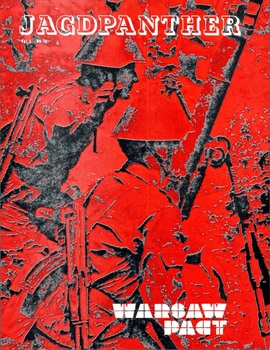 |
Issue #14:
Take a journey with us back to July 1976, when a small wargame club in Amarillo Texas (led by Steve Cole) turned into a real company that produced an award-winning magazine filled with articles, variants, and reviews. The "Iron Age" of JagdPanther continued with color cardstock covers, one-piece multi-color maps, and die-cut counters.
The game in this issue was WARSAW PACT, a World War III game with the Russian invasion of western Europe. The main history article was about the problems faced by the Warsaw Pact in conquering Europe.
Rules variants included alternate minor nation activations in THIRD REICH, a better First Punic War scenario for PUNIC WARS, a way to spread out units in any strategic land game, tracking pilots in BATTLE OF BRITAIN, the missing spells for SORCERER, British amphibious landings in any game about the North African campaign against Rommel, attacking German dockside depots in NARVIK, forming battle groups from destroyed units in FRANCE 1940, rules improvements for COMBINED ARMS, and splitting fire in MIDWAY.
Alternate history scenarios included German units in SPANISH CIVIL WAR, an alternate starting line for WAR IN THE EAST, German and Italian intervention in CHACO, and the German intervention in PORT ARTHUR.
New units included: submarines in the SPI game CA, stats for newly deployed real world units in MECH WAR, airborne and Marine units for REVOLT IN THE EAST, Dutch units in CROMWELL, shore batteries in WOODEN SHIPS AND IRON MEN, masked merchantmen in GLOBAL WAR, stats for more armored vehicles for TANK, and ironclads in the game FRIGATE.
New scenarios were provided for PANZER ARMEE AFRIKA (focusing on El Alamein), American intervention in a South American banana war in VIVA, a later scenario for WHITE BEAR AND RED MOON, a Wake Island scenario for MARINE, unbalanced scenarios in any naval game, WEST WALL (using units from each of the four games in the others), an alternative WW3 scenario for ANVIL-DRAGOON, and an Italian scenario for PANZER LEADER.
Reviews included BAR LEV, SEA STRIKE, BRANDY STATION, and FORMALHAUT II.
This issue has been scanned from the best available copy.
Buy on Warehouse 23
Buy on Drive Thru RPG
Buy on Wargame Vault
Buy a hard copy
|
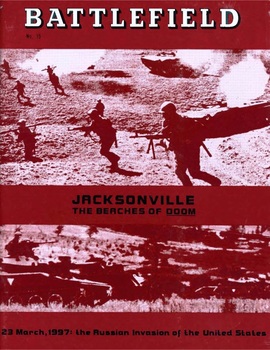 |
Issue #15:
The issue presaged a new age with a new title (Battlefield) to get away from the WW2-based title of JagdPanther. To keep up the high count of many articles, a new "rapid fire" feature included several short articles so that others could be longer and some new regular features (Design & Analysis, Update) were added.
The game in this issue was Jacksonville: The Beaches of DOOM. This was a game about a Soviet invasion of Florida and well suited the national malaise of the time. This was an operational-level wargame in which units had a "protection" factor that approaching enemy units had to overcome before they could get into direct combat and fight.
Rules variants included alternate victory conditions for RUSSIAN CAMPAIGN, variants for WAR IN EUROPE, line of communication rules for ARNHEM, javelins in LEGION, Panama rules for INVASION AMERICA, FAST CARRIERS, and more realistic rules for FIRST INDOCHINA WAR.
Alternate history scenarios included new alliances for DRAGON PASS, and OPERATION OLYMPIC.
New units included the French fleet for WAR AT SEA, 1950s units for MECH WAR, and FIREFIGHT.
New scenarios were provided for KOREA and SORCERER.
Reviews included GUDERIAN, ROCROI, RUSSIAN CIVIL WAR, and JERUSALEM 70AD.
This issue has been scanned from the best available copy.
Buy on Warehouse 23
Buy on Drive Thru RPG
Buy on Wargame Vault
Buy a hard copy
|

